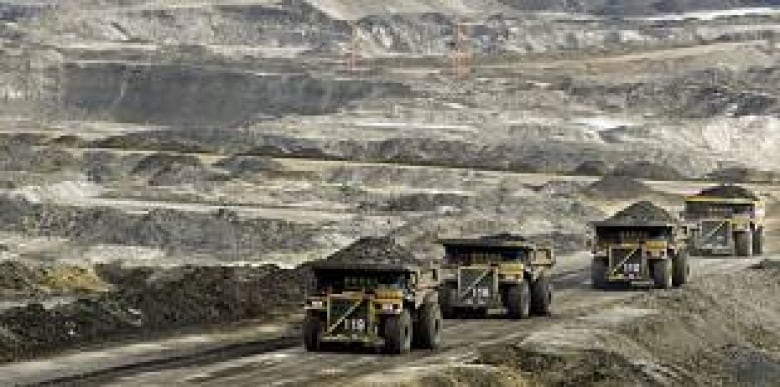Expanded oilsands monitoring planned
The impact of Alberta's oilsands on air quality, water quality and biodiversity will be monitored together under a new plan released by the federal government.

The plan, announced by Environment Minister Peter Kent on Thursday,integrates air quality and biodiversity monitoring with previously announced water quality monitoring.
The planalso boosts the number of monitoring sites andspecifically looks atimpacts downstream and downwind of development.
Kent said Ottawa will start work with theAlberta government and industry to implement the monitoring plan "almost immediately."He estimated it will cost up to $50 million a year and said it will be paid for by the oilsands industry.
Plan details
The plan includes many components already in place to monitor the oilsands, but will sample more sites over a greater geographic area more often for more kinds of data. The number of measurements at a given site will be increased or decreased depending on previous results.
The three main components are:
- Water: Water quality and quantity will be monitored in the Lower Athabasca River, its tributaries, and lakes in the region that might be sensitive to acid rain from oilsands emissions. Concentrations of contaminants will be measured in both the water itself and the tissues of organisms such as fish.
- Air: Air quality will be measured at 14 sites for a range of contaminants and combined with satellite data. A more scientific approach will be taken compared to existing air monitoring, which has been focused on measuring compliance with regulations.
- Biodiversity: The effectsof contaminants and habitat disturbances on different species will be examined.The monitoring will also try to establishwhether efforts to mitigate those disturbances have been successful.
The components will bebrought together in computer models to figure out how they interrelate.
The government has already begun implementing thefirst part of the water monitoring plan, announced in March.
"I think its very important and it will provide the facts and the science to defend the product, which some abroad are threatening to boycott,"Kentsaid after unveilingthe plan at a news conference in Ottawa.
The U.S. is currently facing pressure fromdifferent interestsas itprepares to decide whether to allow construction of a $7-billion pipeline to transport Canadian crude oil to the U.S. Gulf Coast.
Kentsaid results of the monitoring will dispel what he called misinformation about the oilsands thatisused to "discriminate" against a "great Canadian resource."
Monitoring will provide the hard science to prove the oilsands are "being developed in a responsible, sustainable and constantly improving way," he said.
When asked what will happen if the monitoring uncovers problems, Kent saidthey will be fixed, provided they can be "precisely identified."
The governmenthadreleased awater monitoring planfor the oilsands region in March, followinga criticalreport from the Oilsands Advisory Panel last December.
The scientific panel, appointed by former federal environment minister Jim Prentice, released areport slamming the existing approach to environmental monitoring in the oilsands region. It calledthe efforts "piecemeal," with no links between water and air quality measurements.
'Sound and robust,' scientists say
Elizabeth Dowdeswell, the chair of the panel, said Thursday that panel members, who reviewed the new plan,believeit is "sound and robust."
"It responds to the call for comprehensiveness, scientific rigour, and transparency and accessibility," Dowdeswell said in a statement.
Controversial oilsands
The oilsands of Alberta's Athabasca, Peace River and Cold Lake regionsare the country's largest source of oil, with reserves estimated at between 1.7 trillion and 2.5 trillion barrels.The oil is trapped in a viscous form called bitumen within a mixture of sand, water and clay.
The oilsands near the surface are extracted through open pit mining. But about 80 per cent of oilsands cannot be removed that way. Instead, steam is injected into the ground to thin the bitumen and push it toward the surface. The process is energy intensive and produces waste in the form of toxic tailings.
Because of that, environmentalists have campaigned hard against the oilsands. Oneadvertising campaignlaunched in 2009 them "the source of the dirtiest oil on Earth."
She added that a lot of effort has gone into integrating all parts of the ecosystem over space and time, andthe oilsands monitoring plan isdesigned topredict and adapt to changing circumstances and emerging science.
"The panel notes, however, that the success or failure of the plan will now depend on timely, effective implementation."
Environmental group Greenpeace agreed with the call for quick implementation.
Spokesman Mike Hudema said in a statement that if the government is "serious about addressing the horrific impacts of the tarsands," it would hold off on approving newoilsands projects until after the monitoring program is implemented.
Hudema also noted that while monitoring will show the environmental impacts of the oilsands, it won't do anything to stop them from happening.
"The question is will the federal government actually reduce pollution or only track it better?"
Marc Huot, oil sands policy analyst with the Pembina Institute, welcomed the monitoring plan, but also wondered what will happen when it shows there is a problem.
"People want to know that as we are detecting these impacts, we are actually going to do something about them," Huot told CBC News.
In early July, aprovincially appointment panelreleased areportthat found environmental monitoring in the Alberta oilsands is insufficient and needs to have "rigorous scientific design and execution" to be effective.













_(720p).jpg)


 OFFICIAL HD MUSIC VIDEO.jpg)
.jpg)



























































































